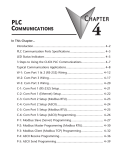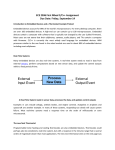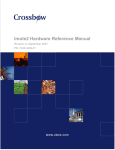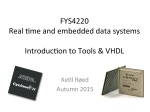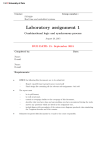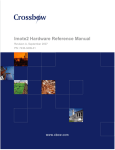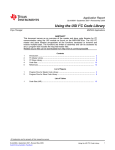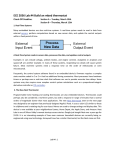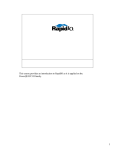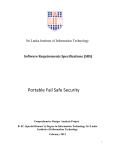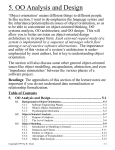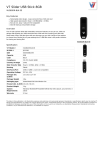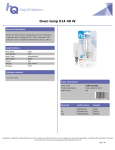Download FYS4220 Lab. exercise 2 due September 29, 2014
Transcript
FYS4220 Lab. exercise 2 due September 29, 2014 Version 1.3 September 8, 2014 Introduction and requirements In this assignment you will design a master controller for a Two Wire Interface (TWI) based on the I2C protocol [1, 2, 3]. The controller will be implemented in VHDL using a state machine approach, and will be used to interface the TMP175 digital temperature sensor [4]. Requirements (due date: 29/09-2014): • The i2c master.vhd design file. • The tb lab2 gx.vhd test bench to validate correct behaviour of the I2C master controller. • A well structured report (with coverpage and in pdf-format) describing what you have done and any problems you have encountered during the work. • The report should include screenshots of the wave diagram generated by the test bench simulation. • The tb lab2 gx.vhd, i2c master.vhd and report (pdf-format) should be attached and submitted by email to ketil.roed [at] fys.uio.no. The filename of the report should contain your name(s) and group number (group numbers will be defined soon). Avoid the use of spaces in the filename (an underscore can instead be used as a separator if needed). Version control Version 1.0 1.1 Date October 1, 2013 October 7, 2013 1.2 October 10, 2013 1.3 September 8, 2014 Comment First published. Updated info concerning the busy signal and sMACK state (See table 1.4). Corrected information in table 1.4 related to the use of ack error (sIDLE) and busy (in table caption). Updated due date and references. Table 1: Version control. 2 Part 1 1.1 The TWI/I2C bus The Two Wire Interface (TWI) is a serial peripheral interface bus and compatible with the I2C protocol. Only two wires are required for communicationg on the bus, a serial data line (SDA) and a serial clock line (SCL). The lines are bidirectional with pull-up resistors, as seen in figure 1.1, to keep a logic high level when no devices are driving the bus. Figure 1.1: Some main features of the I2C bus are: • Each device connected to the bus is addressable by a unique 7-bit (or 10-bit depending on the devive used) address space. • It is a true multi-master bus, however, for this assignment we will design for the simplified case of a single master. • 8-bit serial data transfer • Supports transfer speeds of upto 100 kbit/s in standard mode, up to 400 kbits/s in fast mode, and up to 3.4 Mbit/s in high speed mode. For the TMP175 fast mode is supported without any additional configuration. In order to operate at transfer speeds above 400 kbit/s, the master devices must issue an high speed mode master code as the first byte after a START condition [4]. High speed mode will not be used in this. lab assignment. Keep in mind that the true data transfer rate will be lower than the bus frequency due to the use of control bits during e.g. START, STOP and ackhnowledge conditions. 3 • The number of ICs that can be connected to the same bus is limited only by the maximum bus capacitance of 400 pF. The device that initiates the transfer on the bus is called a master, and the devices controlled by the master are slaves. The bus must be controlled by a master device that generates the serial clock (SCL), controls the bus access, and generates the START and STOP conditions. The main features of the message protocol are: • Each message begins with a START conditions and ends with a STOP condition. START and STOP conditions are always generated by the master. The bus is considered to be busy after the START condition and free again a certain time after the STOP condition. • START condition: A HIGH to LOW transition on the SDA line while the SCL line is HIGH (figure 1.2). • STOP condition: A LOW to HIGH transistion on the SDA line while the SCL line is HIGH (figure 1.3). • Every byte on the SDA line must be 8-bits long. The number of bytes that can be transmitted per transfer (between a START and a STOP condition is unrestricted and determined by the master. • Data is transferred with the most significant (MSB) bit first. • During the transfer of a bit the SDA line must remain stable while SCL is high, as any change in SDA while SCL is high will be interpreted as a control signal. This is clearly seen in figure 1.2 where transitions on SDA takes place during the LOW periods of the SCL, and where the level of SDA remains stable during the HIGH periods of SCL. • Each receiving device, when addressed, is obliged to generate an Acknowledge bit. A device that acknowledges must pull down the SDA line in such a way that the SDA line remains stable LOW during the HIGH period of SCL. Data transfer is sent in eight clock pulses and followed by the Acknowledge bit during the ninth clock cycle. Figure 1.3 shows an example where the SDA is kept low after the LSB to indicate an Acknowledge condition. Afte the Acknowledge bit the SDA is released for a short while before the master pulls it down again in order to prepare for a LOW to HIGH transition indicating a STOP condition. the SCL 4 Figure 1.2: START condition. Figure 1.3: STOP and Acknowledge conditions. 5 1.2 The TMP175 digital temperature sensor The TMP175 is a digital temperature sensor with an internal Analog-to-Digital (A/D) converter and internal configuration and storage registers. The internal register structure is depicted in figure 1.4. The temperature register is used to store a 9-, 10-, 11-, or 12-bit Figure 1.4: TMP175 register structure [4]. output of the most recent conversion. Two bytes must be read to obtain the data, of which the respective 9-, 10-, 11-, or 12 MSBs are the temperature bits. The converter resolution (see table VIII in [4]) can be determined by manipulating the respective resolution control bits (R1 and R2) in the configuration registers (see figure 1.5). E.g., in order to enable the maximum 12-bit temperature resolution, the value x”60” (b”01100000”) must be written to the configuration register. The two LSBs of the pointer register(see figures 1.6 and 1.7) are used to address the internal register of interest. More detailed information about the internal registers can be found in the TMP175 datasheet [4]. Figure 1.5: TMP175 configuration register Figure 1.6: TMP175 pointer register 6 Figure 1.7: Pointer addresses of the internal registers in the TMP175. 1.3 The I2C master controller: i2c master.vhd In this lab. assignment you will implement a master controller module that must be able to: • Address the TMP175 on the I2C bus, • write to the pointer register in order to address the internal registers of the TMP175, • write or read data to or from the internal registers of the TMP175. 1.3.1 Top-level interface The top-level signal and generic interfaces are listed in tables 1.1 and 1.2. Generics are useful to increase the flexibility of the VHDL code and will in this case be used to determine internal enable signals in addition to the SCL clock frequency. More information about generics can be found on page 127 in [5]. Internal signals to be used are listed in table 1.3. Signal name clk areset n ena addr rnw data wr data rd busy ack error sda scl Direction width Description in 1 system clock in 1 asynchronous active low reset in 1 module enable in 7 address of target slave in 1 Read/nWrite command (’0’=write) in 8 data to be written to slave out 8 data read from slave out 1 indicates transaction in progress out 1 flagged if no acknowledge from slave inout 1 bidirectional serial i2c data inout 1 bidirectional serial i2c clock Table 1.1: Top-level signal interface of the i2cmaster.vhd. All signals are of type std logic or std logic vector. 7 Generic name system clk bus clk Type Default value Description integer 50 000 000 system clock in Hz integer 400 000 i2c bus clock in Hz Table 1.2: Top-level generic interface of the i2cmaster.vhd. Signal name state state ena Type statetype std logic Width 1 Description state machine signal enables state transition (duration 1 system clk cycle) enable signal used for START and STOP conditions,data sample, and acknowledge internal i2c clk signal output enable for scl Internal ack. error flag (ack error <= ack error i) internal rnw bit (rnw i <= addr rnw(0)) interal sda signal latched address and Read/nWrite bit latched data to slave latched data from slave to 7 counter to keep track of data bit scl high ena std logic 1 scl clk scl oe ack error i std logic std logic std logic 1 1 1 rnw i std logic 1 sda int addr rnw std logic std logic vector 1 8 data tx data rx bit count std logic vector 8 std logic vector 8 integer range 0 Table 1.3: Internal signals 8 1.3.2 The state machine process The main control functionality will be implemented using a 1-process state machine according to the transition state diagram shown in figur 1.8.To help you getting started a brief description of each state is given in table 1.4. Note that the state machine process will run synchronous to the system clk and that a dedicated signal, state ena, will be used to trigger the state transitions, see 1.3.3. The purpose of this trigger signal is to keep the duration of a state in units of the duration of a bit-transfer on the I2C bus. Figure 1.8: Transition state diagram 9 State sIDLE sSTART sADDR sACK1 sWRITE sREAD sACK2 Description In this state the state machine waits for an event on the external enable signal ena. If external signal ena = ’1’ then sample inputs data wr, addr and rw. Concatenate addr and rw into the 8-bit addr rnw. Release the SDA line (pull sda int high). If ack error was active when entering sIDLE, it should only be reset when ena = ’1’. The purpose of this state is to generate a START condition on the I2C bus at the center of the high period of SCL. On entering sSTART pull sda int high. When scl high ena = ’1’ then pull sda int low (center point of SCL high period). During this state the address bits in addition to the rnw bit will be written to the I2C bus. Assign addr rnw(bit count) to sda int. If bit count is not zero then decrement bit count. If bit count is zero, assign default value of 7 to bit count. After writing the address to the I2C bus, the corresponding slave should acknowledge by pulling SDA LOW. The master must therefore release SDA. (Pull sda int high). When scl high ena = ’1’ then check status of SDA line. If sda = ’1’ then assert ack error. During this state the respective data bits will be written to the I2C bus. Assign data tx(bit count) to sda int. If bit count is not zero then decrement bit count. If bit count is zero, assign default value of 7 to bit count. During this state the slave will write data to the I2C bus. The master must therefore release the SDA line (Pull sda int high). If scl high ena = ’1’ then assign sda to data rx(bit count). If bit count is not zero then decrement bit count. If bit count is zero, assign default value of 7 to bit count. When the master has transferred the 8-data bits the slave will acknowledge this transfer by pulling SDA low during the ninth SCL clock cycle. During this state the master can also accept new commands. The master must therefore release the SDA line (pull sda int high). Pull busy low. If the external enable signal ena is kept high at the same time as the external rnw signal is kept low, this initiates another byte write transaction and the input data wr should be sampled into data tx. If the external signal ena is kept high but external rnw is high, this indicates a restart condition and both the input data wr and addr should be sampled in addition to the rnw input. When scl high ena = ’1’ then check status of SDA line. If sda = ’1’ then assert ack error. If the external signal ena is pulled low, this indicates end of transactions and sda int should be pulled low when moving to the sSTOP state. 10 sMACK sSTOP 1.3.3 In the master acknowledge state the master can either ACK (sda int = ’0’) in order to continue reading data from the slave or it could NACK (sda int = ’1’) if no more data should be read. The busy line should be pulled low during the sMACK. If the external enable signal ena is kept high at the same time as the external rnw signal is kept low, this indicates a restart condition and both the input data wr and addr should be sampled in addition to the rnw input. If during sMACK the input signal ena is pulled low, this indicates that the read transaction is completed and no more data should be read from the slave. In order to end the transaction, a NACK must be indicated to the slave. (Tips: Set default value of sda int to ’1’. sda int should then be pulled low either if ena = ’1’ to prepare for the ACK, or when (state ena = ’1’ and ena = ’0’) to prepare for a stop condition.). The purpose of this state is to generate a STOP condition on the I2C bus at the center of the high period of the SCL. When scl high ena = ’1’ then pull sda int high. Table 1.4: Description of state machine actions. The busy output port should be active in all states expect the sIDLE,sACK2 and sMACK2 states. The internal timing and trigger signals process The I2C master controller will use the external onboard 50 MHz crystal as the system clock. In order to communicate on the I2C bus, generate the START and STOP conditions, sample the SDA line during reading of data and slave acknowledge, a dedicate process is needed to generate the lower frequency SCL clock and the appropriate internal trigger signals. Based on the generic inputs system clk and i2c clk, this process will use a counter (use process internal variable) to generate the correct timing. This process should generate the internal scl clk according to value of the generic i2c clk, in addition to the two trigger signals state ena and scl high ena. • Both trigger signals should be implemented with a duration of 1 system clock cycle. • The state ena signal will be used to trigger the transition of the state machine and should be generate at the center point of the low period of SCL. • The scl high ena signal will be used to trigger the sampling of the SDA line during a read transaction or acknowledge condition, and the START and STOP conditions. It should therefore be generate at the center point of the high period of SCL. 1.3.4 Controlling the SDA and SCL line The SDA and SCL lines of the I2C bus are bidirectional where pulling the line to ground is considered a logical zero while letting the line float (high impedance ’Z’) is a logical one. For the SCL line an internal output enable signal, scl oe, is used to control if the internal scl clk signal or a high impedance value ,’Z’, is assigned to the output scl. 11 • When scl oe = ’1’ then assign the internal signal scl clk to the output port scl, else, assign ’Z’ to scl. scl oe is controlled by the state machine and the scl output should be active as long as the state machine is not in the state sIDLE. An internal signal, sda int, is used as an intermediate signal for sda and controlled by the state machine. sda int can take the values ’0’ or ’1’. • When sda int = ’1’ assign ’Z’ to sda, else assign ’0’ to sda. Both the sda and scl output should implemented as purely combinational and concurrent statements. 12 Part 2 2.1 Testbench environment To validate the correct behaviour of the I2C master controller you will implement a test bench to perform the following two steps: • Set the temperature resolution to 12-bit. • Read back the value of the temparature register. Tables 2.1 through 2.3 lists the write and read procedures needed to perform these steps. Byte mode 1 write 2 write 3 write Byte value comment “1001000” & rnw = ’0’ address slave and indicate write “00000001” Write the address of the configuration register in to the pointer register “01100000” write to the configuration register and set 12-bit temperature resolution Table 2.1: Write procedure to set 12-bit temperature resolution for the TMP175. The transaction is initiated with a START condition and ended with a STOP condition. Byte mode 1 write 2 write Byte value comment “1001000” & rnw = ’0’ address slave and indicate write “00000000” Write the address of the temp. register in to the pointer register Table 2.2: Write procedure to address the temperature register. The transaction is initiated with a START condition and ended with a STOP condition. 13 Byte mode Byte value ´ 1 write ’1001000´’ & rnw = ’0’ read 2 3 read - comment address slave and indicate read read MSB from temperature register read LSB from temperature register Table 2.3: Read procedure to read the value of the temperature register. The transaction is initiated with a START condition and ended with a STOP condition. 14 References [1] I2C specifications. http://www.nxp.com/documents/user manual/UM10204.pdf. [2] The I2C-bus and how to use it (Including specifications), Philips Semiconductors. http://www.i2c-bus.org/fileadmin/ftp/i2c bus specification 1995.pdf. [3] I2C Bus. http://www.i2c-bus.org. [4] Digital Temperature Sensor with Two-Wire Interface, Burr-Brown Products from Texas Instruments. http://www.ti.com/lit/ds/symlink/tmp175.pdf. [5] Brian Mealy and Fabrizio Teppero, Free Range VHDL, Release 1.17 . http://www.freerangefactory.org/dl/free range vhdl.pdf. 15















